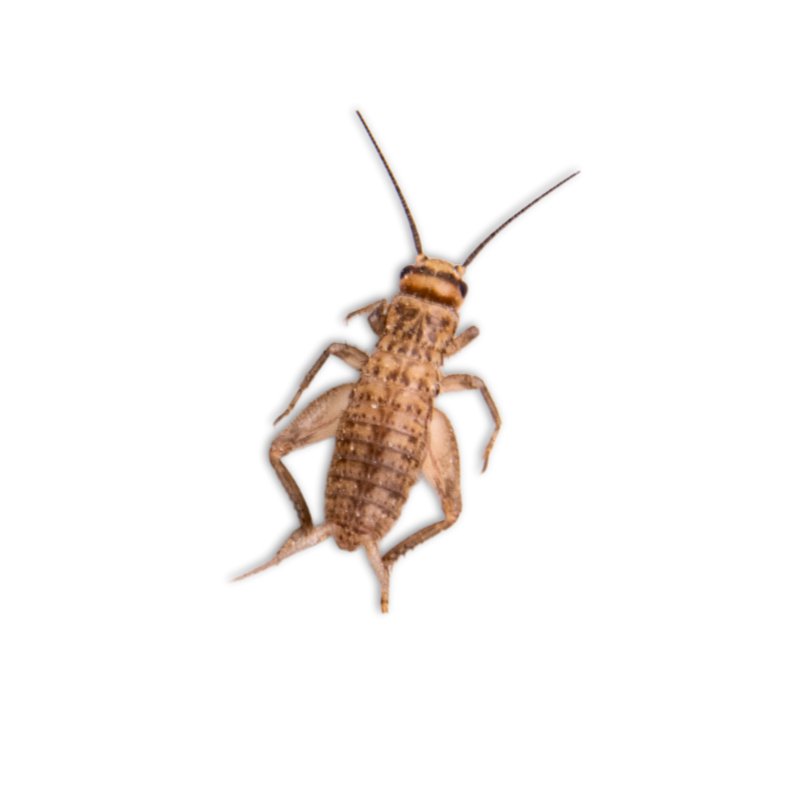Cricket Care Sheet

Cricket - Scientific Name: Acheta domesticus
The house cricket (Acheta domesticus) is a member of the insect Order Orthoptera, a Latin-derived term meaning “straight wing.” Other insects in this group include, grasshoppers, katydids, and crickets, they all share this wing structure and are known for their powerful hind legs and distinctive sounds.
Originally native to Southwest Asia, house crickets have dispersed globally and are commonly found in temperate regions around the world. Beyond their well-known chirping, these small insects play a big role in the environment. Crickets help decompose organic matter, enriching soil health and aiding nutrient cycling. They’re also an important food source for reptiles, birds, amphibians, and small mammals, helping support balanced ecosystems.
In recent years, crickets have also gained attention for their potential as a sustainable protein source for humans. They require far less land, water, and feed than traditional livestock, and produce significantly fewer greenhouse gases—making them a promising solution for future food security and environmental conservation.
A Fluker's Cricket:
Crickets can vary in size, but a Fluker house cricket can get up to an inch in length, from head to thorax or what we would like to say, “head to butt”. These insects are an excellent source of protein and are very easily “gut-loaded” with calcium and other important vitamins for your pets.

NUTRITIONAL BENEFITS
HOUSING AND BEDDING
Crickets are high in protein and low in fat perfect for reptiles, amphibians, and birds. They’re ideal for gut-loading and dusting with calcium or multivitamins to boost your pet’s nutrition.
Use a well-ventilated plastic bin or tank with smooth sides and a screen lid. Line the bottom with dry oats or bran. Add egg crates for hiding and climbing. Keep temps between 75–85°F with low humidity.
FEEDING TO REPTILES
CLEANING AND MAINTENANCE
To feed crickets to your reptile, use feeding tongs or place crickets directly into the habitat. Crickets should be appropriately sized no larger than the space between your pet’s eyes. For best results, gut-load crickets 24–48 hours before feeding by offering them dark leafy greens, sweet potato, or commercial cricket gut-load products. Dusting crickets with a calcium supplement before offering them enhances their value, especially for reptiles prone to metabolic bone disease (like bearded dragons or geckos).
Clean the cricket habitat weekly by removing dead crickets, droppings, and moldy food. Replace egg crates as they become soiled or chewed. To control odor and bacteria, avoid over-humidifying and never leave uneaten fruits or vegetables for more than 48 hours. A clean container ensures better survival rates, reduces disease, and keeps your feeder colony healthy and productive.
DISPOSAL
Dispose of dead crickets by placing them in a sealed bag and discarding them with your household waste. Do not flush crickets or release them outdoors, as they may pose risks to native species or become a nuisance.
INITIAL SET-UP & LONG TERM CARE TIPS
Unpacking Your Crickets
Setting Up a Cricket Keeper
*Note: Fluker Farm's sponsored a grant with Louisiana State University to breed crickets. Dr. Joseph Woodring selectively bred crickets by taking the top 10% heaviest at maturity and then repeating the process. These crickets were incorporated into our breeding stock, for stronger healthier crickets.
